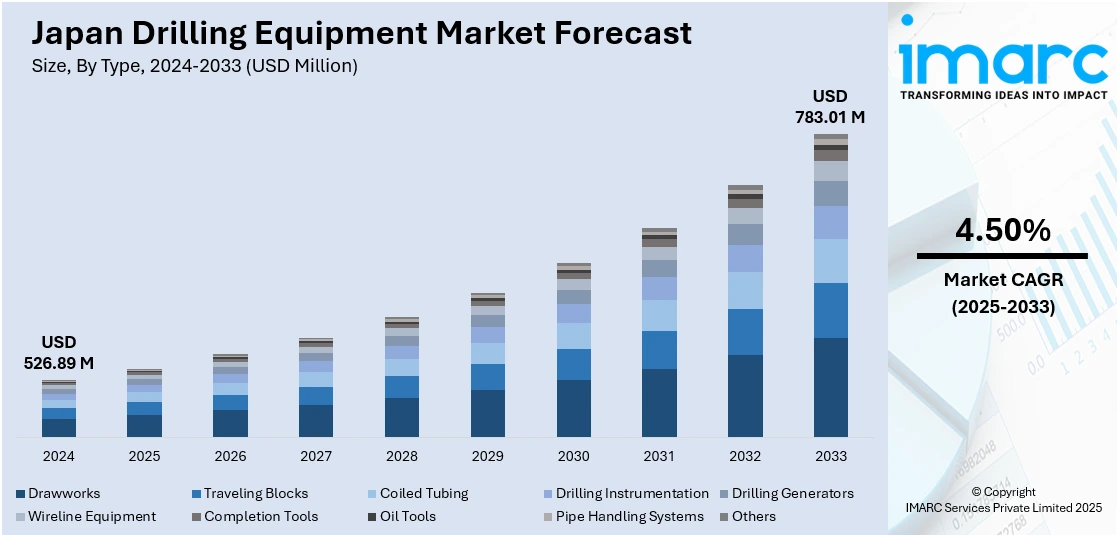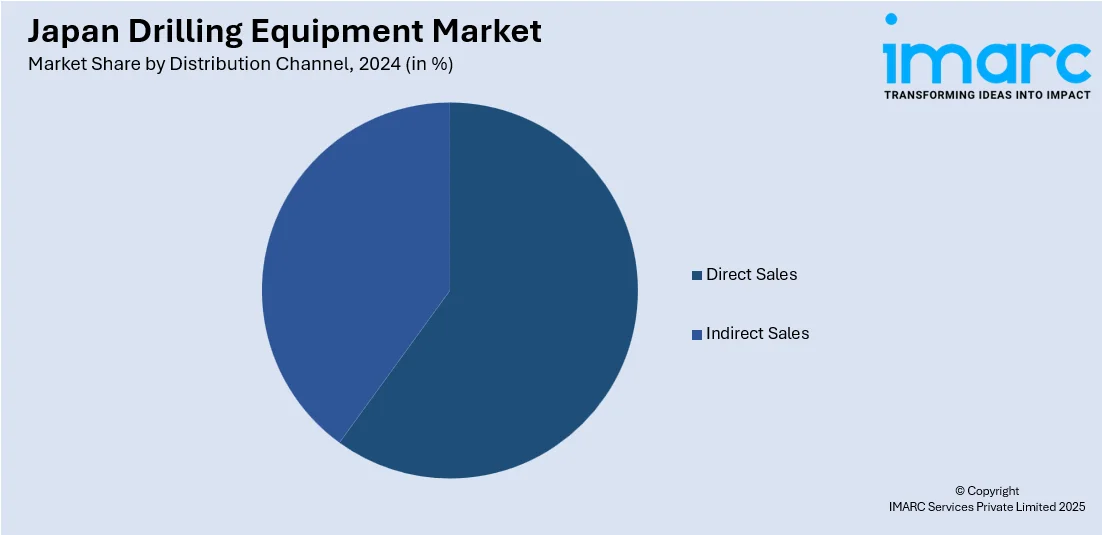
Japan Drilling Equipment Market Size, Share, Trends and Forecast by Type, Category, Power Source, Mount Type, Distribution Channel, End-Use, and Region, 2025-2033
Japan Drilling Equipment Market Overview:
The Japan drilling equipment market size reached USD 526.89 Million in 2024. Looking forward, IMARC Group expects the market to reach USD 783.01 Million by 2033, exhibiting a growth rate (CAGR) of 4.50% during 2025-2033. The market is driven by the increasing oil and gas exploration activities, especially offshore, to ensure Japan’s energy security. Technological advancements in automation and real-time monitoring systems are enhancing efficiency and reducing operational costs in drilling operations, fueling the market. Government policies promoting energy diversification and supporting foreign investments in oil and gas exploration are further augmenting the Japan drilling equipment market share.
|
Report Attribute
|
Key Statistics
|
|---|---|
|
Base Year
|
2024 |
|
Forecast Years
|
2025-2033
|
|
Historical Years
|
2019-2024
|
| Market Size in 2024 | USD 526.89 Million |
| Market Forecast in 2033 | USD 783.01 Million |
| Market Growth Rate 2025-2033 | 4.50% |
Japan Drilling Equipment Market Trends:
Increased Oil and Gas Exploration Activities
Japan's energy profile has undergone a change in its exploration policies, prioritizing the provision of energy security. Though natural oil and gas reserves are not as abundant in the country compared to other parts of the world, it has maximized offshore exploration to gain access to its energy resources. Japan has also been prospecting and developing its offshore oil and gas reserves, specifically off places such as the Nansei Islands and Sea of Japan. With the ongoing high demand for energy, Japan's energy industry needs high-technology and reliable drilling machinery to maximize exploration. This is further necessitated by the government's campaign to guarantee stable provision of energy and decrease reliance on imports. On October 1, 2024, Japan Petroleum Exploration Co., Ltd. (JAPEX) announced plans to conduct an exploratory drilling project in the offshore Hidaka area of Hokkaido to confirm the presence of natural gas. The project, located approximately 50km offshore at a depth of 1,070 meters, will take place from March to May 2026, with public funds covering up to 50% of the drilling costs. If successful, the project could lead to domestically produced natural gas, contributing to Japan's energy security and enhancing JAPEX's corporate value. These initiatives include exploring new technologies for deepwater drilling and offshore resources. Consequently, the Japan drilling equipment market growth is driven by the continuous demand for more efficient machinery designed to operate in challenging marine environments. Furthermore, Japan’s energy policies and its commitment to diversifying energy sources drive the demand for state-of-the-art drilling technologies. As oil and gas exploration activities increase, Japan continues to invest in cutting-edge equipment to sustain its drilling operations and contribute to the overall growth of the sector.

Technological Advancements and Innovation in Drilling Equipment
Innovation plays a significant role in shaping the drilling equipment market in Japan. As the country seeks to modernize its oil and gas sector, technological advancements have become indispensable in ensuring operational efficiency and safety. New innovations such as automation, digitalization, and the integration of real-time data analytics are transforming the way drilling operations are conducted. Japanese companies are increasingly adopting automated drilling systems that improve precision, speed, and safety. These innovations help reduce human error, increase drilling efficiency, and minimize operational costs, making them crucial for both offshore and onshore operations. Additionally, technological advancements in drilling equipment help address environmental challenges, ensuring that operations are carried out in an environmentally responsible manner. Japan’s energy companies are focusing on sustainable practices, such as reducing emissions, improving resource management, and enhancing the overall lifecycle performance of drilling rigs. On October 2, 2024, Japan's deep-sea drilling vessel Chikyu has begun a 106-day expedition to the Japan Trench subduction zone, with a goal to drill to a total depth of 7,877.5 meters below sea level. This research, led by the Japan Agency for Marine-Earth Science and Technology (JAMSTEC), utilizes advanced drilling technology to study the causes of the 2011 Great East Japan Earthquake. As these technologies evolve, there is a growing demand for high-tech, reliable equipment that supports Japan’s strategic goals in the energy sector. The integration of next-generation technologies will continue to play a key role in furthering the development of the market.
Japan Drilling Equipment Market Segmentation:
IMARC Group provides an analysis of the key trends in each segment of the market, along with forecasts at the country and regional levels for 2025-2033. Our report has categorized the market based on type, category, power source, mount type, distribution channel, and end-use.
Type Insights:
- Drawworks
- Traveling Blocks
- Coiled Tubing
- Drilling Instrumentation
- Drilling Generators
- Wireline Equipment
- Completion Tools
- Oil Tools
- Pipe Handling Systems
- Others
The report has provided a detailed breakup and analysis of the market based on the type. This includes drawworks, traveling blocks, coiled tubing, drilling instrumentation, drilling generators, wireline equipment, completion tools, oil tools, pipe handling systems, and others.
Category Insights:
- Automatic
- Manual
The report has provided a detailed breakup and analysis of the market based on the category. This includes automatic and manual.
Power Source Insights:
- Electric
- Non-Electric
The report has provided a detailed breakup and analysis of the market based on the power source. This includes electric and non-electric.
Mount Type Insights:
- Truck Mounted
- Trailer Mounted
The report has provided a detailed breakup and analysis of the market based on the mount type. This includes truck mounted and trailer mounted.
Distribution Channel Insights:

- Direct Sales
- Indirect Sales
The report has provided a detailed breakup and analysis of the market based on the distribution channel. This includes direct sales and indirect sales.
End-Use Insights:
- Construction
- Oil and Gas
- Mining
- Water Management
- Others
The report has provided a detailed breakup and analysis of the market based on the end-use. This includes construction, oil and gas, mining, water management, and others.
Regional Insights:
- Kanto Region
- Kansai/Kinki Region
- Central/Chubu Region
- Kyushu-Okinawa Region
- Tohoku Region
- Chugoku Region
- Hokkaido Region
The report has also provided a comprehensive analysis of all major regional markets. This includes Kanto Region, Kansai/Kinki Region, Central/Chubu Region, Kyushu-Okinawa Region, Tohoku Region, Chugoku Region, and Hokkaido Region.
Competitive Landscape:
The market research report has also provided a comprehensive analysis of the competitive landscape. Competitive analysis such as market structure, key player positioning, top winning strategies, competitive dashboard, and company evaluation quadrant has been covered in the report. Also, detailed profiles of all major companies have been provided.
Japan Drilling Equipment Market News:
- On September 4, 2024, ITOCHU Corporation, along with six other companies, announced their involvement in the "Engineering Design Work for Japanese Advanced CCS Projects" selected by the Japan Organization for Metals and Energy Security (JOGMEC). The project includes appraisal drilling to assess CO2 storage sites, a critical phase for the implementation of carbon capture and storage (CCS) technology aimed at achieving Japan's carbon neutrality and emission reduction goals.
Japan Drilling Equipment Market Report Coverage:
| Report Features | Details |
|---|---|
| Base Year of the Analysis | 2024 |
| Historical Period | 2019-2024 |
| Forecast Period | 2025-2033 |
| Units | Million USD |
| Scope of the Report |
Exploration of Historical Trends and Market Outlook, Industry Catalysts and Challenges, Segment-Wise Historical and Future Market Assessment:
|
| Types Covered | Drawworks, Traveling Blocks, Coiled Tubing, Drilling Instrumentation, Drilling Generators, Wireline Equipment, Completion Tools, Oil Tools, Pipe Handling Systems, Others |
| Categories Covered | Automatic, Manual |
| Power Sources Covered | Electric, Non-Electric |
| Mount Types Covered | Truck Mounted, Trailer Mounted |
| Distribution Channels Covered | Direct Sales, Indirect Sales |
| End-Uses Covered | Construction, Oil and Gas, Mining, Water Management, Others |
| Regions Covered | Kanto Region, Kansai/Kinki Region, Central/Chubu Region, Kyushu-Okinawa Region, Tohoku Region, Chugoku Region, Hokkaido Region |
| Customization Scope | 10% Free Customization |
| Post-Sale Analyst Support | 10-12 Weeks |
| Delivery Format | PDF and Excel through Email (We can also provide the editable version of the report in PPT/Word format on special request) |
Key Questions Answered in This Report:
- How has the Japan drilling equipment market performed so far and how will it perform in the coming years?
- What is the breakup of the Japan drilling equipment market on the basis of type?
- What is the breakup of the Japan drilling equipment market on the basis of category?
- What is the breakup of the Japan drilling equipment market on the basis of power source?
- What is the breakup of the Japan drilling equipment market on the basis of mount type?
- What is the breakup of the Japan drilling equipment market on the basis of distribution channel?
- What is the breakup of the Japan drilling equipment market on the basis of end-use?
- What is the breakup of the Japan drilling equipment market on the basis of region?
- What are the various stages in the value chain of the Japan drilling equipment market?
- What are the key driving factors and challenges in the Japan drilling equipment market?
- What is the structure of the Japan drilling equipment market and who are the key players?
- What is the degree of competition in the Japan drilling equipment market?
Key Benefits for Stakeholders:
- IMARC’s industry report offers a comprehensive quantitative analysis of various market segments, historical and current market trends, market forecasts, and dynamics of the Japan drilling equipment market from 2019-2033.
- The research report provides the latest information on the market drivers, challenges, and opportunities in the Japan drilling equipment market.
- Porter's five forces analysis assist stakeholders in assessing the impact of new entrants, competitive rivalry, supplier power, buyer power, and the threat of substitution. It helps stakeholders to analyze the level of competition within the Japan drilling equipment industry and its attractiveness.
- Competitive landscape allows stakeholders to understand their competitive environment and provides an insight into the current positions of key players in the market.
Need more help?
- Speak to our experienced analysts for insights on the current market scenarios.
- Include additional segments and countries to customize the report as per your requirement.
- Gain an unparalleled competitive advantage in your domain by understanding how to utilize the report and positively impacting your operations and revenue.
- For further assistance, please connect with our analysts.
 Request Customization
Request Customization
 Speak to an Analyst
Speak to an Analyst
 Request Brochure
Request Brochure
 Inquire Before Buying
Inquire Before Buying




.webp)




.webp)












